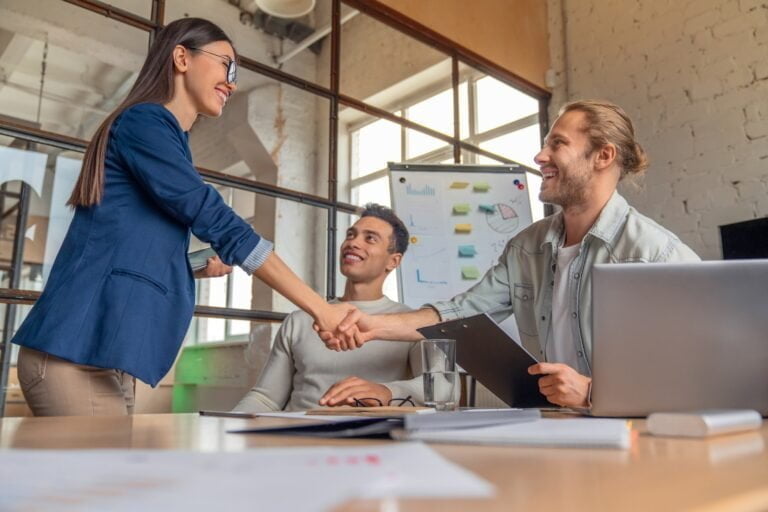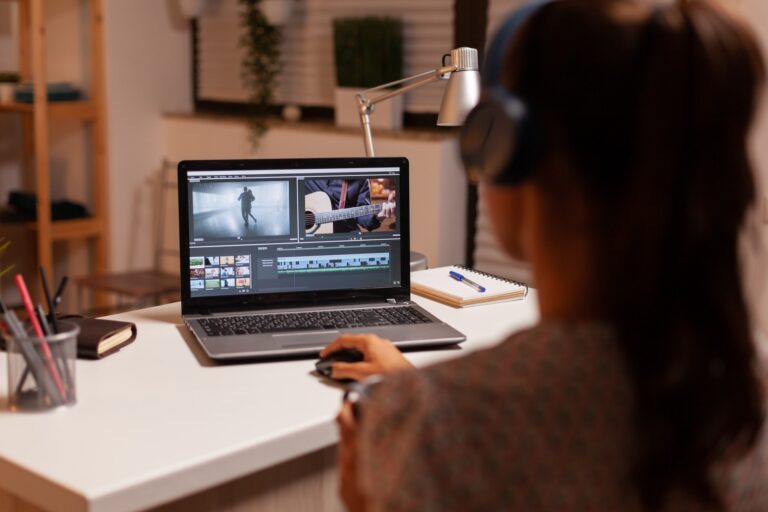What is brand identity, and why is it important?
Brand identity is the visual and verbal representation of a company or product’s unique characteristics, values, and personality. It encompasses the logo, typography, colour palette, imagery, and overall design elements that distinguish a brand from its competitors.
But brand identity goes beyond just visuals; it also defines how a brand sounds and feels through its tone of voice and messaging. Why is brand identity important?
Well, think about this: standing out becomes crucial for success in a world where countless brands are vying for attention. Your brand identity serves as the face of your business – it’s what people recognize and associate with your products or services.
It helps you differentiate yourself from competitors and communicate your value proposition to your target audience. A strong brand identity builds customer trust by conveying consistency, reliability, and professionalism.
When customers consistently encounter cohesive branding elements such as logos, colours, or fonts across different touchpoints like websites or packaging designs, they develop confidence in a company’s offerings. This trust leads to increased customer loyalty and advocacy – the ultimate goals for any business.
The role of brand identity in creating a strong brand presence
Creating a solid brand presence is vital for capturing market share and establishing long-term success. Brand identity is integral to achieving this by enabling businesses to stand out amidst the fierce competition. Your brand’s visual elements are like ambassadors carrying your message into the world: they catch people’s attention while embodying your core values.
A well-designed logo instantly communicates who you are as a business – whether aiming for professionalism with sleek lines or creativity with playful shapes. Typography also contributes significantly to crafting an appealing persona for your brand.
Different fonts evoke different emotions – serif fonts may denote tradition and reliability, while script fonts exude elegance or sophistication. You can influence how your audience perceives your brand by selecting appropriate typography.
A colour palette is equally crucial. Colours have psychological associations and can evoke specific emotions or moods.
For instance, blue often represents trust and security, while red can convey passion or energy. Consistently using colours that align with your brand’s personality and message helps create a memorable visual identity.
In today’s digital age, imagery and graphics are powerful tools for quickly capturing attention and conveying messages. Carefully curated visuals that align with your brand’s style guide elevate the overall perception of your brand and facilitate recognition among consumers.
Brand identity design encapsulates the essence of who you are as a business in a visually appealing way. It grabs attention and fosters trust, loyalty, and recognition from your target audience.
By harnessing the power of branding elements like logos, typography, colour palettes, and imagery consistently across different touchpoints, you can shape a strong brand presence that leaves a lasting impression on customers. So let’s explore these elements in more detail to help you create a unique brand identity!
Logo Design: Creating a Visual Representation of Your Brand
Regarding brand identity, your logo is the visual centrepiece that encapsulates your brand’s essence. It’s the face of your business, instantly recognizable and unforgettable. A well-designed logo should be simple yet powerful enough to convey a strong message about your brand.
In creating a logo, you must consider various elements: shape, colour, typography, and imagery. Shape plays a significant role in defining the mood and personality of your brand.
Think about how circles represent unity or how triangles convey stability and strength. Colour selection is crucial in logo design as different colours evoke different emotions.
For example, red can communicate energy and passion, while blue conveys trustworthiness and reliability. Choose colours that align with your brand’s core values and resonate with your target audience.
Typography is another critical aspect of logo design. Fonts have personalities too!
You want to select fonts that reflect the character of your brand—whether it’s sleek and modern or classic and elegant. Experiment with different typefaces until you find one that captures what you want to communicate.
An effective logo should be versatile enough to work across various platforms—whether on a website header or printed on marketing materials like business cards or billboards. Remember that simplicity is vital; an overly complicated logo may lack impact and fail to capture attention.
Typography: Choosing the Right Fonts to Convey Your Brand’s Personality
While typography may seem like just selecting fonts for your brand communication materials, it goes far beyond that—it shapes how people perceive your brand’s personality. The right choice of fonts can elevate your messaging from ordinary to extraordinary!
Serif fonts exude tradition and authority—a perfect choice for brands aiming for a classic, sophisticated image. On the other hand, sans-serif fonts lend a modern and clean aesthetic, making them ideal for brands seeking a contemporary feel.
Play around with different font families to find the one that aligns best with your brand’s tone and values. Consider the readability of your chosen fonts across various mediums.
Fonts that work well on digital screens may not translate as effectively in print materials. Opt for fonts that maintain legibility at different sizes and consistency across all brand touchpoints.
Pairing fonts is an art form in itself. Combining contrasting fonts can create visual interest and hierarchy while using similar font families can provide a cohesive and balanced look.
Experiment with font pairings to find combinations that complement each other harmoniously. Remember, typography should never be an afterthought—it should be an intentional choice that reflects your brand’s personality and enhances its overall identity.
Colour Palette: How Colors Can Evoke Emotions and Shape Perceptions
Colours hold immense power—they can evoke emotions, influence actions, and shape perceptions. When it comes to brand identity design, choosing the right colour palette is crucial in effectively conveying your brand’s values. Start by understanding colour psychology—studying how colours impact human behaviour and emotions.
For example:
- Red: symbolizes energy, passion, urgency
- Blue: represents trustworthiness, calmness
- Green: communicates growth, harmony
- Yellow: evokes optimism, happiness
Your colour palette should align with your brand’s personality and target audience preferences while considering industry standards or competitors’ colours. For instance, bold and vibrant colours may work well for a youthful brand, while muted and earthy tones may be more suitable for a natural or organic brand.
Remember to balance using too many colours, which can create visual chaos, and using too few colours, which may not effectively communicate your brand’s multifaceted nature. A well-thought-out colour palette can create an immediate emotional connection with your audience.
Imagery and Graphics: Using Visuals to Enhance Brand Messaging
A picture is worth a thousand words—or in branding, it can be worth a thousand loyal customers. Using imagery and graphics in brand identity design is essential in capturing attention, conveying key messages, and fostering emotional connections with your target audience. Selecting the right visuals involves understanding your brand’s story, values, and target audience preferences.
Are you aiming for a sleek and modern aesthetic? Or perhaps you want to evoke nostalgia through vintage-inspired imagery?
Whatever the case, visuals should align with your overall branding strategy. Consistency is critical when incorporating imagery and graphics into your brand identity.
Establishing distinctive visual elements—such as specific filters or photography styles—can help create a cohesive image across all touchpoints. This consistency ensures that every visual aspect reflects your core brand values.
Additionally, consider the power of symbolism when incorporating graphics into your branding efforts. Symbols can transcend language barriers and convey complex concepts succinctly.
Whether through icons or illustrations, leverage visuals to enhance message clarity and leave lasting impressions on your audience. Incorporating high-quality visuals adds aesthetic appeal and communicates professionalism and attention to detail—a vital aspect of building trust with potential customers.
Crafting a Memorable Brand Story
Defining your brand’s values, mission, and vision
A brand story serves as the foundation of your entire brand identity. It is crucial to start by defining your brand’s core values.
Ask yourself questions like: What do you believe in? What principles guide your decision-making process?
These values will shape the perception of your brand and attract like-minded customers who resonate with them. Next, articulate your brand’s mission and vision.
Your mission statement should clearly state what you aim to achieve as a brand, while the vision statement paints a picture of the future you envision for your brand. For example, if you’re a sustainable fashion company, your mission might be to create eco-friendly clothing, while your vision could be a world where sustainable fashion is the norm.
Establishing a unique selling proposition (USP)
In today’s competitive market, having a unique selling proposition (USP) is essential to differentiate yourself from competitors. Your USP makes you stand out in the minds of consumers and gives them a reason to choose you over others. Identify what sets your brand apart from others in the industry.
It could be an innovative product feature, exceptional customer service, or an unconventional problem-solving approach. Whatever it may be, it should resonate with your target audience and solve their pain points better than anyone else.
Once you’ve identified your USP, weave it into every aspect of your branding efforts. Ensure it shines through in all communication channels so customers instantly recognize why they should choose you over competitors.
Creating a compelling narrative that resonates with your target audience
Humans are wired for storytelling; we connect emotionally with narratives more than anything else. Craft an authentic and compelling story about how and why your brand emerged.
Share the passion, struggles, and triumphs behind its inception. Consider your target audience and what kind of story would resonate with them.
Are they seeking adventure, reliability, or a sense of belonging? Tailor your narrative to evoke the desired emotions and captivate their attention.
Consider incorporating the real-life experiences of customers who’ve benefitted from your brand. These testimonials add credibility and help potential customers visualize themselves experiencing similar positive outcomes.
Wrap your story in a captivating narrative that unfolds across various touchpoints. Whether through social media campaigns, website content, or advertisements, consistency is vital to creating a memorable brand story that leaves a lasting impression.
Crafting a memorable brand story involves defining your brand’s values, mission, and vision as the guiding principles for your identity. Establishing a unique selling proposition is crucial to differentiate yourself from competitors in the market.
Creating a compelling narrative that resonates with your target audience will build emotional connections and leave a lasting impact on potential customers. Remember to infuse authenticity throughout every storytelling aspect for maximum impact in capturing hearts and minds.
Building Consistency Across Touchpoints
Website Design: Translating your brand identity into an online experience
Creating a solid online presence is crucial in today’s digital landscape. Your website serves as the virtual face of your brand, and it must effectively convey your brand identity to visitors. To achieve this, start by aligning the visual elements of your website with your brand’s aesthetics.
This includes incorporating your logo prominently on each page, using typography that complements your brand personality, and selecting a colour scheme that reflects your brand’s values. In addition to visual elements, the content on your website should also reflect your brand’s tone and messaging.
Use language that resonates with your target audience and showcases the essence of who you are as a brand. Whether through informative articles or captivating product descriptions, every word should contribute to building a cohesive narrative around your brand.
Packaging Design: Making sure your product aligns with your brand image
Packaging design is critical in capturing consumer attention and creating a memorable impression of your product. It should not only be visually appealing but also reflect the essence of your brand. Start by considering how packaging materials, colours, shapes, and textures can represent different aspects of what you stand for.
For example, if you strive for eco-friendliness, opt for sustainable packaging made from recycled materials. If elegance is one of the key attributes associated with your brand identity, choose sleek and sophisticated packaging designs that exude luxury.
Remember that packaging is more than just outer aesthetics; it involves functionality and user experience. Ensure that practical considerations such as ease of use, storage efficiency, and protection are considered while maintaining consistency with the overall look and feel of the package design.
Social Media Presence: Maintaining consistent branding across platforms
Maintaining a consistent brand presence across various platforms is paramount in an era where social media has become an integral part of our lives. Each social media platform offers unique opportunities and challenges for brand communication.
However, the key is to maintain a cohesive brand image throughout. Start by ensuring your profile and cover photos are consistent across all platforms.
This helps users recognize your brand instantly, regardless of which platform they encounter you on. Additionally, utilize the same colour palette, typography, and tone of voice in your posts across social media channels.
Adapting your content strategy to fit each platform’s specific requirements while maintaining brand consistency is essential. For example, on Instagram, focus on captivating visuals that showcase your brand’s aesthetic appeal; on Twitter, employ concise yet engaging messaging that aligns with your tone of voice.
Remember that social media is about broadcasting promotional content and building relationships with your audience. Engage with followers by responding to comments and messages promptly and authentically.
Targeting Your Audience Effectively
Conducting Market Research to Understand Your Target Demographic
Do you ever feel like you’re shouting into the abyss, not knowing if anyone is listening? Well, fear not!
Understanding your target demographic is the key to avoiding this futile exercise. Market research allows you to dive deep into your potential customers’ minds and determine what makes them tick.
It involves gathering information about their preferences, behaviour and needs to tailor your branding efforts accordingly. To conduct effective market research, start by identifying your target audience.
Who are they? What are their characteristics?
Once you have a clear picture, use various methods like surveys, focus groups, and online analytics tools to gather data. This will give you valuable insights into consumer buying patterns, lifestyle choices, and preferred communication channels.
Developing Buyer Personas to Tailor Your Branding Efforts
Now that you have all this juicy market research, it’s time to put it to good use. Enter buyer personas – fictional representations of your ideal customers that encompass vital traits and behaviours.
Creating buyer personas helps humanize your target audience so that you can craft more targeted and personalized branding efforts. Start by giving each persona a name and backstory – think of them as characters in a novel that embody different aspects of your target demographic.
Dive deep into their motivations, challenges, aspirations, and even fears. Consider factors like age group, profession, interests/hobbies, geographic location – anything that could influence their purchasing decisions.
Once you have these personas defined with intricate detail (the more specific, the better), use them as a guide for everything from marketing campaigns to product development. You’ll hit the bullseye every time by tailoring your brand messaging specifically for each persona’s unique needs and desires.
Conclusion
In a world filled with endless choices and distractions, effectively targeting your audience is crucial for establishing a solid brand identity. Conducting market research and developing buyer personas will pave the way for successful branding efforts that genuinely resonate with your customers. Remember, knowledge is power!
By understanding your target demographic and their preferences, you can create tailored marketing strategies that cut through the noise and capture their attention. With every interaction, ensure that you speak directly to their hearts and minds, address their pain points, and showcase how your brand can improve their lives.
So go forth with confidence! Armed with market research insights and well-defined buyer personas, you have the tools to build a brand that stands out in the crowd.
Embrace authenticity, stay true to your vision, and watch as your audience connects with you on a deeper level. Remember: You have the power to leave an indelible mark on the hearts of your customers – so make it count!









